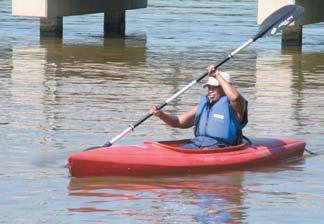Environmental Justice
Hann Baykeeper
Africa’s First Waterkeeper By/Par Malick Sene, Hann Baykeeper International Coordinator
»Along the Atlantic coast of Africa, near Senegal’s capital city of Dakar, lies Hann Bay. Twenty-five years ago Hann Bay was one of the most sumptuous bays in the world. It is here that tropical ocean currents from the north and cool ocean currents from the south converge, providing a rich fishery of tilapia and grouper, which migrate along the bay’s mud-sand bottoms before they reach our plates, bringing us together for our daily lunch. Communities of traditional fishermen regarded Hann Bay as Mame Coumba Bang, the goddess of the sea. Before going out to sea for their daily catch they decorated their boats with writings and drawings for Mame Coumba Bang, to protect them from danger and to receive the daily blessing of catching a fish to feed their family. The community stayed alive, stayed healthy, because of a culture that was spiritual, sustainable and equitable. In the 1980s, villagers noticed that their bay was becoming increasingly polluted because of the lack of sewage infrastructure and untreated wastewater from industry. The City of Dakar and new, multinational industries like Mobil and the French box-
manufacturer Carnaud regularly dumped wastewater into the bay. Fishermen started complaining to the government that they had to go further and further offshore for their daily catch. The government made small concessions to these fishermen, extending their fishing range, saying they could do nothing else. They never admitted that the real problem was pollution. By the early 1990s, villagers, fishermen sailors and community organizations began to see that their bay was suffering serious pollution. The quality of the fish had declined dramatically and disease vectors like flies and mosquitoes covered the water’s surface. People were getting sick. The bay had reached a breaking point and no one, not the government nor the companies responsible, was willing to deal with the pollution. That’s when our organization, ASC Yarakh, stepped in. Since the early 1980s, ASC Yarakh has served as a sports and culture organization for the people of Hann Village, organizing soccer games, beach wrestling and traditional boat racings around Hann Bay. We organized ethnic and religious ceremonies like drum celebrations that kept
Hann Baykeeper
Premier Waterkeeper d’Afrique »La baie de
Hann est située sur la côte Atlantique de l’Afrique, à proximité de Dakar, capitale du Sénégal. Il y a vingt-cinq ans, la baie de Hann figurait parmi les plus magnifiques du monde. C’est le point de convergence des courants marins tropicaux du nord et des courants marins froids du sud et l’on y trouve le tilapia et le mérou en grande abondance, poissons qui migrent le long des fonds sablonneux et boueux de la baie avant de finir dans nos assiettes, nous réunissant autour du déjeuner quotidien. Les communautés de pêcheurs traditionnels considéraient la baie de Hann comme Mame Coumba Bang, le déesse de la mer. Chaque jour, avant de partir pour pêcher en mer, ils décoraient leurs bateaux d’écrits et de dessins pour Mame Coumba Bang, pour être protégés contre les dan50
Waterkeeper Magazine Winter 2008
gers de la mer et recevoir la bénédiction journalière d’une bonne pêche suffisante à nourrir leur famille. La communauté demeurait vivante et saine en raison d’une culture qui était spirituelle, durable et juste. Au cours des années 80, les villageois ont remarqué que leur baie devenait de plus en plus polluée en raison du manque d’infrastructure d’égouts et des eaux usées non traitées provenant de l’industrie. La ville de Dakar aussi bien que de nouvelles industries multinationales telles que Mobile Oil et le fabricant français de boîtes dénommé Carnaud jetaient régulièrement leurs eaux usées dans la baie. Les pêcheurs ont commencé à se plaindre auprès du gouvernement qu’ils devaient aller de plus en plus au large pour pêcher. Le gouvernement a fait des petites concessions pour ces pêcheurs, étendant www.waterkeeper.org








